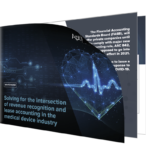From coffee to music to clothing and more, the subscription economy is exploding and here to stay. With growth expected to expand from USD 650 billion in 2021 to 1.5 trillion by 2025, industries you might not consider subscription-ready are relooking at their business models and making the leap.
The medical device and technology industry (MedTech) is one of these areas. Poised for steady growth but with margin pressures and regulatory mandates to contend with, looking at innovative new bundles and offerings can offer new sources of revenue, improve customer retention and generate a more predictable stream of annual recurring revenue (ARR).
But like any business model shift, there are complexities to be addressed by the industry, specifically around compliance with the revenue recognition standard ASC 606/IFRS 15 and the lease accounting standard ASC 842/IFRS 16 which both come into play for MedTech organizations.
What servitization looks like for MedTech companies
Traditionally, a MedTech company provides a client – typically a clinic, hospital, or other healthcare settings – with a piece of equipment and any other supplementary, required items. The client purchases these materials as a capital expenditure and ownership is transferred to the client.
However, today we see an increasing embrace of ‘servitization’ by MedTech companies. In its simplest terms, servitization refers to industries using their products to sell outcomes. In the case of MedTech companies, this can mean looking at new ways of pricing and bundling the use of machinery, consumables, and services. For example, a Product-as-a-Service offering could allow a client to pay a fixed, recurring (typically monthly) payment that covers the use of the asset, maintenance, parts and labor, product upgrades, and can even include other clinical or operational services. While this shifts the budget to operational expenditures, it can also give clients more flexibility to design a package that best fits their needs. The supplier keeps ownership of the asset which can help minimize risk.
Accounting for MedTech subscriptions under ASC 606/IFRS 15 and ASC 842/IFRS 16
Even before the increasing shift to servitization models, MedTech organizations were in the somewhat unique position of having to account for the intersection of two separate but overlapping standards. With the rise of new business models and corresponding contracts, the complexities and challenges increase under these accounting standards.
Revenue recognition complexities
Under the traditional model, a client could sign a long-term contract and purchase medical equipment and other necessary items. The contract could include line items for supplementary products and maintenance. While the company would need to account for the revenue recognition under ASC 606 by determining the Standalone Selling Price (SSP) of each line item and accounting for it correctly as a product or service, the level of complexity was low and most of the revenue could be recognized upfront.
With a Product-as-a-Service or other servitization model, contracts are more complex and can include a variety of different line items and offerings, which need to be accounted for separately and revenue recognized monthly. This creates complexities around SSP and determining performance obligations.
Lease Accounting complexities
New ways of structuring leases like reagent rentals, bundled offerings, and usage-based leases are allowing companies to structure more advantageous and innovative deals – for both organizations and their customers. But this adds accounting complexity, especially in light of revenue recognition and lease accounting standards.
Reagent rentals, for example, contain an embedded lease and must be accounted for under lessor accounting and the company must decide whether to apply the practical expedient or separate the non-lease components from the associated lease components. In a bundled lease, multiple SKUs are bundled and invoiced to a customer as one line item in a contract. This means the contract line item is not reflective of the fair market values of the individual items that make up the bundle. The invoiced amount must be reallocated to the multiple SKUs and the correct standalone selling price (SSP) of each SKU must be generated. Lease line items must also be pulled out of the bundle or the larger contract and accounted for appropriately.
A US Medical Technology company moved from selling large capital equipment to leasing equipment at no charge and selling a subscription for the consumables used with that machine. This was a major shift as the company moved from a traditional model with large deals, to a subscription business model focused on recurring revenue.
Pace of change in a subscription business
In a subscription economy, the product cycle is much shorter, with considerably more iterations. Part of the value of a servitization business model within the MedTech industry is the variety and flexibility that can be offered to clients based on their needs.
While this is good for clients and can be good for the MedTech organization, it can result in higher transaction volumes and more complex accounting. It also presents a challenge in the short term as organizations will need to demonstrate why key KPIs and financial statements have changed and show long-term forecasting that proves the value of the shift from large up-front payments to smaller payments in a recurring revenue stream.
How can organizations with this cross-over challenge remove complexity?
Aptitude Software offers a market-leading lease accounting and revenue recognition solution to automate the challenges and complexities associated with the standards ASC 606 and ASC 842. This integrated solution can support MedTech organizations as they take advantage of innovative new business models and capitalize on new opportunities in the market.



